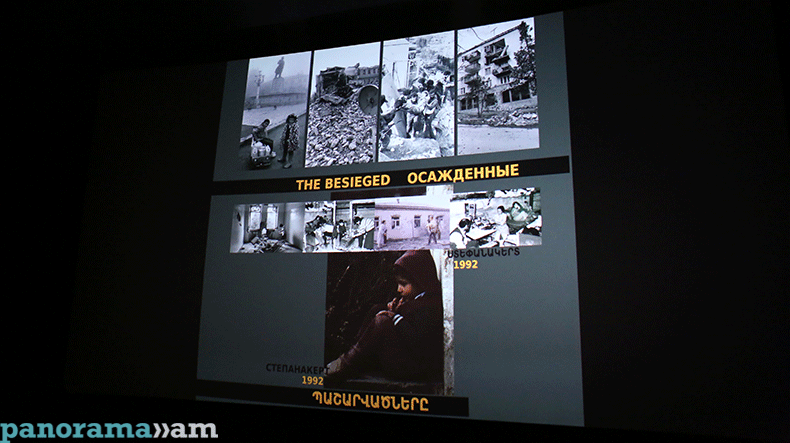
Documentary “The Besieged” telling about human sufferings under Azerbaijani siege premiered in Yerevan
The Documentary “The Besieged” telling about the sufferings of the Stepanakert residents under Azerbaijani blockade in the winter months of 1992 was premiered today in Yerevan. The film has been produced by the the Public Relations and Information Center affiliated with the President’s Office and is authored by political scientists Armen Minasyan and Hrant Melik-Shahnazaryan.
The 40-minute length documentary features archive footages, witness accounts and memories of the Stepanakert residents, who were trapped by Azerbaijanis forces with all essential supplies, including water, electricity, food and medicines virtually cut off.
“There is no word about war in the documentary, which only highlights human stories and witness accounts. We decided to feature the ordinary humans with their rights - first of all - to life, since they were often forgotten in the turmoil of the war,” Armen Minasyan told in his remarks before the screening.
In his words one of the reasons for the film production was the growing Azerbaijani speculations over Khojaly events. “We decided to cover those events, given the direct linkage between them and the Stepanakert siege to spread light on all the nuances of the prehistory that preceded those events and the need to liberate the settlements,” Minasyan said, adding the ultimate goal of the film is to present both the domestic and international community the causes and the prehistory of the conflict around Nagorno Karabakh.
The co-author of the documentary Hrant Melik-Shahnazaryan, who lived in Stepanakert at that time, stressed that the film attempts to show the Azerbaijani long-practiced policy continues to these days.
“The matter is especially about Azerbaijani policy aimed at eliminating the Armenian population, which actually failed in 1991-92 due to the breaking of the Stepanakert siege. However, the risk and the permanent threat has always persisted for the Armenian population. The film is aimed at revealing Azerbaijani anti-Armenian policy through from a new perspective,” Melik-Shahnazaryan said, adding the documentary might serve a factual ground for researchers studying the conflict.
It was noted that the film will be translated into several languages to make it reach as large audience as possible.
To remind, the siege of the Nagorno Karabakh Autonomous Region started in Autumn 1989, when Azerbaijan blockaded railroad lines to Armenia, while roads passing near the Azerbaijani settlements became extremely dangerous. As a response to the calls by Karabakh people for reunification with Armenia, the residents of Stepanakert were trapped by Azerbaijanis in a blockade with all essential supplies, including water, electricity, food and medicines virtually cut off.
It was in these conditions of the total blockade that since September 2 1991 Azerbaijan additionally subjected adjacent settlements of Stepanakert to shelling and bombardments, including the airdrome near the Azerbaijani Khojaly village at a time when atrocities against Armenians were widespread.
To silence the Azerbaijani intensive and constant shelling, break the imposed blockade and save the starving the city population from annihilation, Armenian self-defense forces were compelled to get reorganized in late February, 2012 and liberate the Khojalu village (Ivanyan), while the Lachin (Berdzor) corridor was ultimately opened in May 18.
Two Azerbaijani reporters - Chingiz Mustafayev and Eynulla Fatulayev - who objectively documented and voiced the accurate record of the historical events had different fates. Mustafayev was killed months after the operation while Fatulayev after serving his four-year imprisonment, was later freed and established a news portal committed to intensive praising and glorification of Azerbaijani president Ilham Aliyev.
Newsfeed
Videos






























